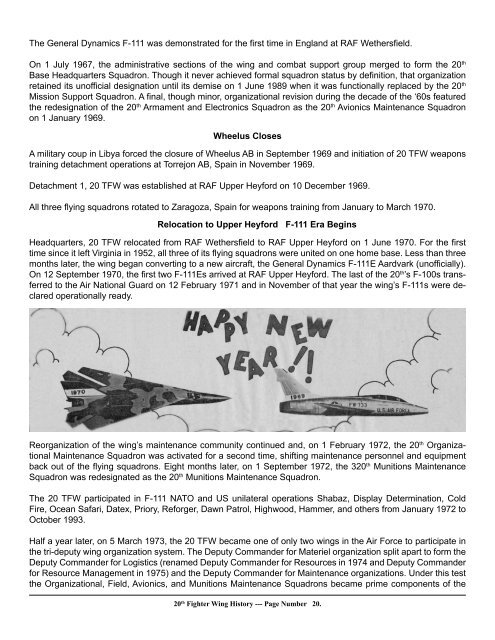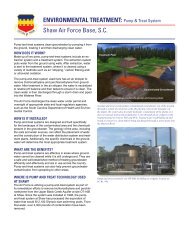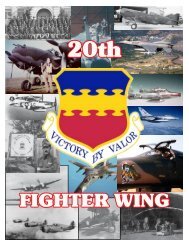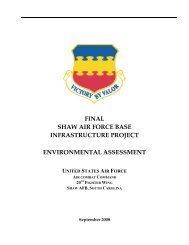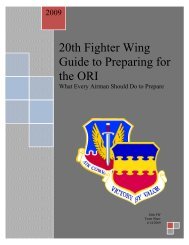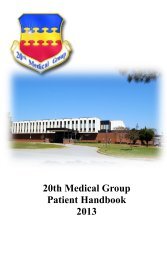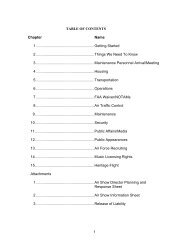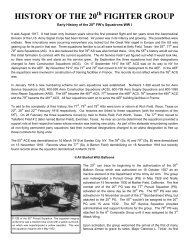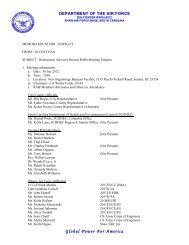HISTORY OF THE 20th FIGHTER WING - Shaw Air Force Base
HISTORY OF THE 20th FIGHTER WING - Shaw Air Force Base
HISTORY OF THE 20th FIGHTER WING - Shaw Air Force Base
You also want an ePaper? Increase the reach of your titles
YUMPU automatically turns print PDFs into web optimized ePapers that Google loves.
The General Dynamics F-111 was demonstrated for the first time in England at RAF Wethersfield.<br />
On 1 July 1967, the administrative sections of the wing and combat support group merged to form the 20 th<br />
<strong>Base</strong> Headquarters Squadron. Though it never achieved formal squadron status by definition, that organization<br />
retained its unofficial designation until its demise on 1 June 1989 when it was functionally replaced by the 20 th<br />
Mission Support Squadron. A final, though minor, organizational revision during the decade of the ‘60s featured<br />
the redesignation of the 20 th Armament and Electronics Squadron as the 20 th Avionics Maintenance Squadron<br />
on 1 January 1969.<br />
Wheelus Closes<br />
A military coup in Libya forced the closure of Wheelus AB in September 1969 and initiation of 20 TFW weapons<br />
training detachment operations at Torrejon AB, Spain in November 1969.<br />
Detachment 1, 20 TFW was established at RAF Upper Heyford on 10 December 1969.<br />
All three flying squadrons rotated to Zaragoza, Spain for weapons training from January to March 1970.<br />
Relocation to Upper Heyford F-111 Era Begins<br />
Headquarters, 20 TFW relocated from RAF Wethersfield to RAF Upper Heyford on 1 June 1970. For the first<br />
time since it left Virginia in 1952, all three of its flying squadrons were united on one home base. Less than three<br />
months later, the wing began converting to a new aircraft, the General Dynamics F-111E Aardvark (unofficially).<br />
On 12 September 1970, the first two F-111Es arrived at RAF Upper Heyford. The last of the 20 th ’s F-100s transferred<br />
to the <strong>Air</strong> National Guard on 12 February 1971 and in November of that year the wing’s F-111s were declared<br />
operationally ready.<br />
Reorganization of the wing’s maintenance community continued and, on 1 February 1972, the 20 th Organizational<br />
Maintenance Squadron was activated for a second time, shifting maintenance personnel and equipment<br />
back out of the flying squadrons. Eight months later, on 1 September 1972, the 320 th Munitions Maintenance<br />
Squadron was redesignated as the 20 th Munitions Maintenance Squadron.<br />
The 20 TFW participated in F-111 NATO and US unilateral operations Shabaz, Display Determination, Cold<br />
Fire, Ocean Safari, Datex, Priory, Reforger, Dawn Patrol, Highwood, Hammer, and others from January 1972 to<br />
October 1993.<br />
Half a year later, on 5 March 1973, the 20 TFW became one of only two wings in the <strong>Air</strong> <strong>Force</strong> to participate in<br />
the tri-deputy wing organization system. The Deputy Commander for Materiel organization split apart to form the<br />
Deputy Commander for Logistics (renamed Deputy Commander for Resources in 1974 and Deputy Commander<br />
for Resource Management in 1975) and the Deputy Commander for Maintenance organizations. Under this test<br />
the Organizational, Field, Avionics, and Munitions Maintenance Squadrons became prime components of the<br />
20 th Fighter Wing History --- Page Number 20.


